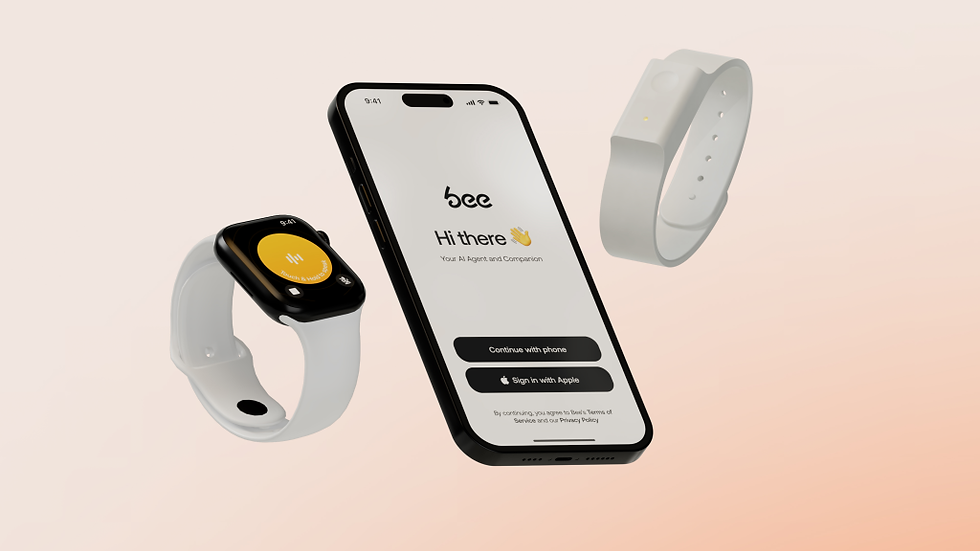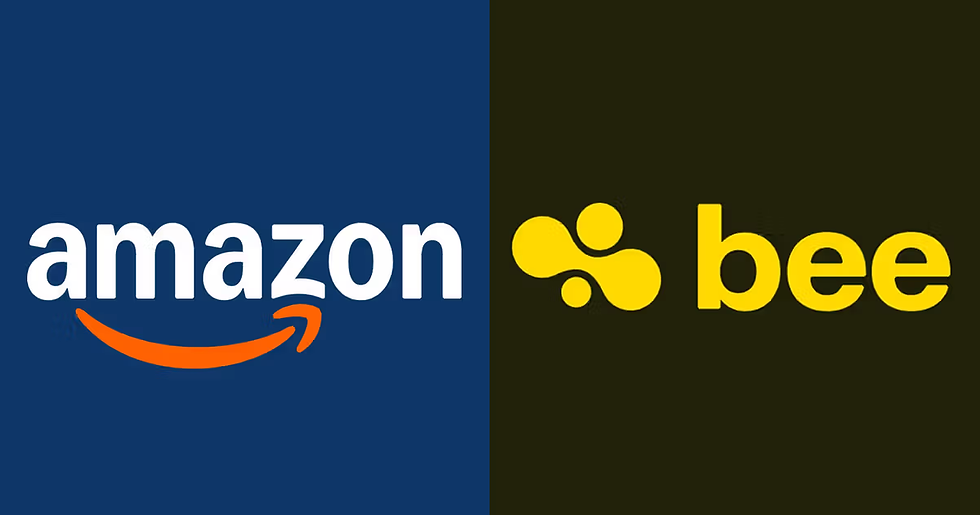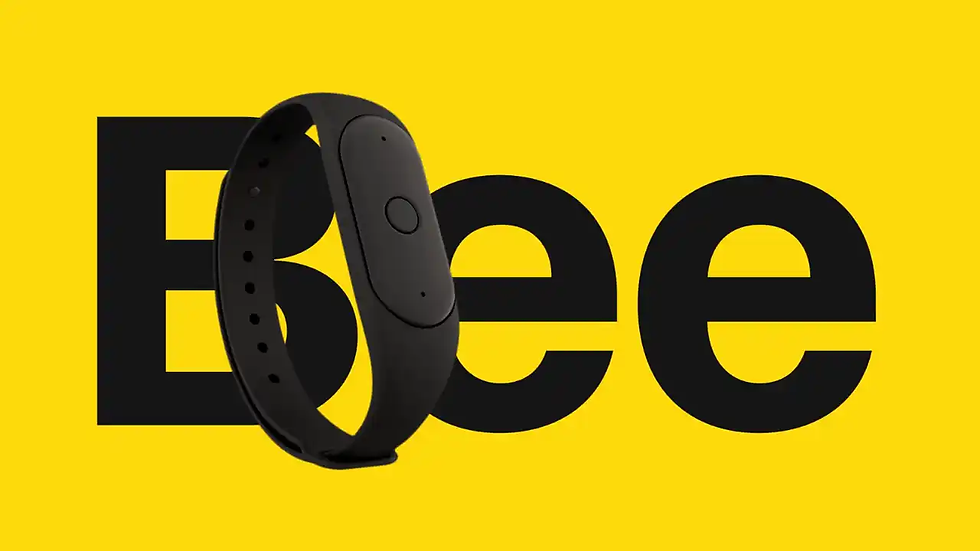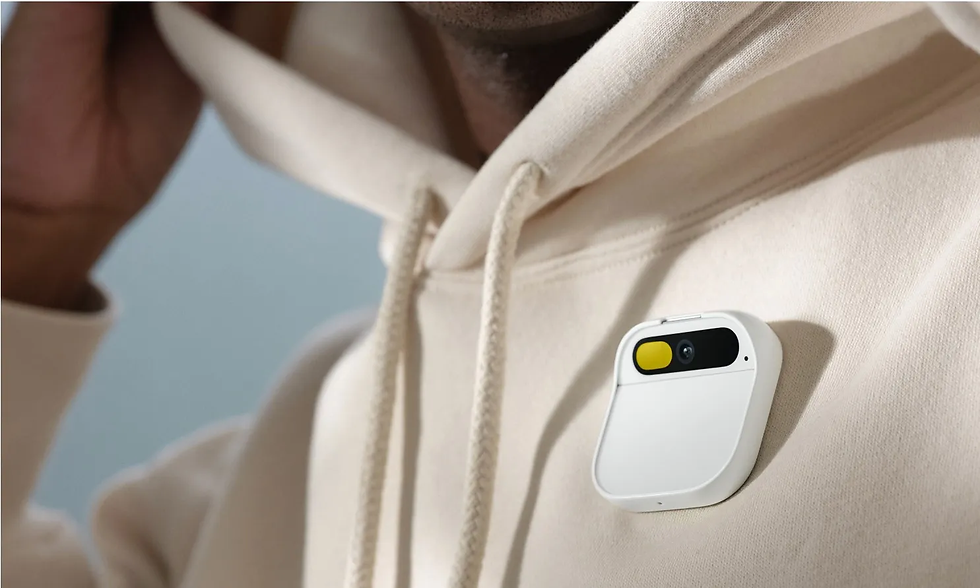Amazon’s AI Wearable Strategy: Inside the Bee Acquisition and Voice Recording Tech
- Aisha Washington

- Aug 5
- 11 min read
In the rapidly evolving landscape of artificial intelligence (AI) and wearable technology, Amazon is emerging as a formidable player with a strategic focus on integrating AI into wearable devices. This article dives deep into Amazon’s AI wearable strategy, with a particular focus on its acquisition of Bee — a cutting-edge voice recording technology startup — and how this move is poised to reshape the future of smart wearables.
From enhancing user interaction with voice AI to developing seamless, context-aware devices, Amazon is leveraging its extensive expertise in AI and cloud computing to revolutionize how wearables function. Whether you are a tech enthusiast, industry analyst, or developer, understanding Amazon's approach offers critical insights into the future of AI wearables.
The Emergence of AI in Wearable Technology

The intersection of AI and wearable technology has transformed how we interact with digital devices. From fitness trackers to smart glasses, wearables have evolved from simple data-gathering gadgets to intelligent companions capable of contextual understanding.
Why AI is Essential for Wearables
AI turns raw sensor data into actionable insights, enabling wearables to:
Understand user context (location, activity, preferences)
Predict needs and automate tasks (e.g., health alerts, reminders)
Provide natural interfaces through voice, gesture, and visual recognition
AI integration in wearables is not merely about adding processing power; it fundamentally changes the interaction paradigm. For example, AI-driven contextual awareness allows a device to detect if a user is running, sitting in a meeting, or commuting, then adjust notifications or functionalities accordingly. This prevents interruptions during important moments and enhances user satisfaction. Furthermore, AI models can learn individual preferences over time, tailoring responses to specific users — such as recognizing different voices, accents, or even emotional cues.
Market Trends Driving AI Wearables
The global wearable market is forecasted to reach $70 billion by 2027, fueled by smartwatches, hearables, and AR glasses. AI integration is a critical differentiator:
Improved personalization: AI enables devices to learn individual behavior patterns, enabling features like adaptive workout plans, sleep improvement suggestions, or personalized music recommendations based on mood or activity level.
Enhanced health monitoring: Real-time analytics improve chronic disease management by detecting anomalies such as irregular heart rhythms or blood oxygen levels, alerting users or healthcare providers promptly.
Seamless voice interaction: Natural language processing (NLP) removes barriers between users and devices, enabling hands-free control in diverse environments — from noisy gyms to quiet offices.
Additionally, emerging AI techniques such as federated learning allow wearables to improve their models by learning locally on devices without sending raw data to the cloud, addressing privacy while enhancing personalization. This is particularly important as users become more privacy-conscious.
Amazon’s strategy aims to capitalize on these trends by creating more intelligent, voice-enabled wearables that integrate deeply with their ecosystem, enhancing both convenience and user engagement.
Amazon’s Strategic Move: The Acquisition of Bee

In late 2023, Amazon acquired Bee, a stealthy startup specializing in advanced voice recording and processing technologies. This acquisition marks a pivotal moment in Amazon’s strategy to dominate voice-enabled wearables.
What is Bee?
Bee developed proprietary voice recording algorithms that capture high-fidelity audio while minimizing background noise and power consumption. Their technology supports:
Continuous passive listening without draining battery life
Context-aware voice activation that adapts to different environments
Privacy-centric data processing, ensuring sensitive information is protected
Bee’s innovation lies in combining sophisticated signal processing with machine learning models that dynamically adjust to ambient conditions. For example, in a loud café, Bee’s tech can amplify the user’s voice while suppressing chatter and clatter, enabling accurate voice commands without requiring repeated attempts. Furthermore, their system intelligently detects when the user is speaking to the device or engaged in a conversation with others, avoiding false activations.
Why Amazon Acquired Bee
Amazon’s Alexa platform has revolutionized voice assistants but faces challenges in wearables due to limited hardware capabilities and privacy concerns. Bee’s technology addresses these pain points by:
Enhancing voice capture accuracy for on-the-go devices such as earbuds or glasses, where microphones are smaller and more susceptible to interference.
Enabling always-on listening with minimal energy usage, critical for devices that must operate all day without frequent charging.
Facilitating edge processing where voice data is analyzed locally rather than sent to the cloud, improving latency and privacy.
This aligns with Amazon’s broader vision of embedding Alexa into a wide range of form factors beyond Echo speakers — making voice interaction truly ubiquitous. For instance, integrating Bee’s tech into smart glasses could allow users to control navigation apps, receive notifications, or dictate messages hands-free while on the move.
Industry insiders suggest this acquisition will accelerate Amazon’s entry into smart eyewear and hearable devices markets (TechCrunch report).
Voice Recording Technology: The Core of Bee’s Innovation

Understanding Bee’s technology provides valuable insight into how Amazon plans to optimize voice interfaces in wearables.
Advanced Audio Signal Processing
Bee employs several proprietary techniques that enable devices to extract clean voice signals from noisy, dynamic environments:
Feature | Description | Benefit |
|---|---|---|
Beamforming Microphone Arrays | Uses multiple microphones to isolate the speaker's voice by focusing on sound from a specific direction | Enhances clarity in noisy environments such as busy streets or gyms where multiple sound sources compete |
Acoustic Echo Cancellation | Removes echoes caused by device playback, such as music or calls | Improves call and command recognition quality, allowing voice commands during media playback without interference |
Adaptive Noise Suppression | Dynamically filters out background sounds by analyzing the acoustic environment in real-time | Enables reliable voice wake-up even in crowded places, such as airports or concerts, reducing false triggers |
These capabilities allow wearables to capture crisp voice commands even during workouts, commuting, or social settings. For example, a user wearing Bee-powered earbuds can issue a command like “Call Mom” while jogging beside traffic, and the system accurately distinguishes that command from surrounding noise.
Energy Efficiency Innovations
Wearable devices have strict battery constraints due to their small form factor. Bee’s algorithms are optimized for low-power DSP (digital signal processor) chips, enabling:
Always-listening capabilities without significant battery drain, achieved by offloading continuous audio processing to ultra-low-power hardware accelerators.
On-device wake word detection without cloud dependency, allowing devices to respond immediately without network latency or data transmission.
Efficient data compression for faster processing and reduced memory footprint, extending operational time and enabling longer use between charges.
The energy savings are crucial for wearables like smart glasses or earbuds, where bulky batteries are impractical. Bee’s innovations help maintain a balance between responsiveness and battery life, a common trade-off in voice-enabled devices.
Privacy by Design
Given growing privacy concerns around voice assistants, Bee incorporates several features to protect user data:
Localized audio processing to prevent unnecessary data transmission, ensuring that voice commands are interpreted directly on the device unless user-initiated actions require cloud processing.
User-controlled data retention policies that allow individuals to manage what audio data is stored or deleted, giving users transparency and control.
Robust encryption for any cloud communication, safeguarding voice data from interception or misuse.
This privacy-first approach enables Amazon to build trust with consumers wary of “always listening” devices. By integrating these features into Alexa-enabled wearables, Amazon can address consumer privacy demands while maintaining functionality.
How Amazon Integrates AI with Wearables

Amazon’s wearable AI strategy extends beyond hardware acquisition; it leverages its cloud infrastructure, machine learning models, and ecosystem partnerships to deliver a comprehensive user experience.
Alexa: The Voice AI Backbone
Alexa remains central to Amazon’s vision for wearables:
Embedded in devices like Echo Frames and Echo Buds, Alexa provides a consistent voice interaction layer across form factors.
Continuously improved NLP models for better natural language understanding (NLU) allow Alexa to interpret complex commands, understand context, and manage multi-turn conversations.
Personalized experiences via user profiling and contextual awareness enable Alexa to tailor responses, such as adjusting news briefings based on user preferences or suggesting calendar events relevant to the user’s location or schedule.
Alexa’s evolving capabilities include proactive suggestions based on user context—made possible through AI models running locally and in the cloud. For example, if a wearable detects the user is running late for a meeting, Alexa might prompt a reminder or suggest alternate routes.
Edge Computing Meets Cloud Intelligence
Amazon enables hybrid processing to optimize performance and privacy:
Edge computing allows real-time responses for commands like “play music” or “answer call” without latency, crucial for smooth user experiences in wearables where immediate feedback is expected.
Cloud AI analyzes complex queries such as “What’s my schedule today?” or “Translate this conversation,” leveraging Amazon’s vast computational resources and data.
This division optimizes speed and privacy while expanding functionality. For instance, sensitive voice data can be processed locally to minimize exposure, while more computationally intensive tasks are offloaded to the cloud.
Cross-Device Ecosystem Integration
Wearables become part of a larger smart ecosystem powered by Amazon Web Services (AWS):
Data synchronization with smartphones, tablets, and home devices ensures seamless transitions between contexts. For example, a user can start a workout on their smartwatch and see detailed analytics on their tablet later.
Integration with Amazon services like shopping lists, calendar, and entertainment creates a unified experience. Voice commands can add items to shopping carts or control smart home devices without switching gadgets.
Third-party developer support through Alexa Skills Kit enables customized experiences, such as specialized fitness coaching, language learning, or workplace productivity tools.
Practical Example: Fitness Tracking Meets Voice Assistance
Imagine an Amazon smartwatch that monitors your vitals during a run and notifies you via voice if your heart rate exceeds safe levels — all while allowing hands-free control through Bee-powered voice tech. The watch might say, “Your heart rate is elevated. Would you like me to adjust your workout plan?” This seamless experience blends health monitoring with intuitive AI interaction, empowering users to make informed decisions in real time without distraction.
Similarly, in professional contexts, a warehouse worker wearing Alexa-enabled earbuds could receive voice-guided instructions for inventory management, verifying stock levels or checking shipment details hands-free, increasing efficiency and safety.
Implications for Consumers and Enterprises

Amazon’s AI wearable strategy is set to impact various stakeholders significantly by introducing new capabilities and use cases.
For Consumers
Enhanced usability: Voice commands reduce reliance on tiny touchscreens, allowing users to interact naturally even when hands are occupied or gloved.
Improved accessibility: Hands-free operation benefits people with disabilities, including those with mobility or vision impairments, by providing alternative interaction modes.
Better health insights: Continuous monitoring paired with AI-driven alerts enables proactive health management, early detection of issues, and personalized coaching.
Privacy assurance: On-device processing reduces data exposure risks, addressing growing consumer concerns about surveillance and data misuse.
Additionally, consumers can expect seamless integration with other Amazon services, enabling features like voice shopping, calendar management, and home automation directly from wearables.
For Enterprises
Amazon’s tech opens new avenues:
Workplace productivity: Voice-enabled wearables can assist warehouse workers or field technicians with real-time information, reducing errors and improving response times.
Healthcare applications: Remote patient monitoring integrated with Alexa for telehealth enables clinicians to track patients’ vitals and provide timely interventions, enhancing care continuity.
Retail innovation: Personalized shopping experiences via smart glasses or earbuds can offer real-time product information, promotions, or guided navigation within stores.
Training and compliance: Voice AI can provide step-by-step instructions or safety reminders in industrial environments, reducing accidents and ensuring regulatory adherence.
Market Opportunities
Analysts project that combining Alexa with AI wearables could generate billions in revenue by tapping into untapped markets such as AR glasses and hearables beyond consumer electronics . The convergence of AI, voice, and wearables is expected to create entirely new categories of devices and services, driving growth for Amazon and its partners.
Challenges and Ethical Considerations in Voice AI Wearables

Despite its promise, Amazon faces several hurdles in realizing its AI wearable ambitions.
Technical Challenges
Battery life limitations remain critical despite advances. Continuous listening and AI processing must balance performance with energy consumption to avoid frequent recharging.
Ensuring accurate voice recognition across diverse accents, dialects, speech impediments, and noisy environments requires extensive training data and sophisticated models.
Balancing on-device vs. cloud computing for optimal performance involves trade-offs between latency, privacy, and computational power.
Hardware constraints such as microphone placement, size, and sensitivity impact voice capture quality in compact wearables like earbuds or glasses.
Privacy and Security Concerns
Voice recording naturally raises alarms about:
Unintended activation or eavesdropping risks, where devices might record conversations without explicit consent.
Data misuse or unauthorized access, including potential breaches exposing sensitive personal information.
User consent transparency, ensuring individuals are fully aware of when and how their voice data is collected and used.
Amazon must maintain rigorous safeguards and clear communication to build trust, including transparent privacy policies, user controls, and regular security audits.
Ethical Considerations
Avoiding bias in AI models that may misinterpret certain speech patterns, accents, or dialects, which could lead to exclusion or frustration for some user groups.
Ensuring equitable access so wearables don’t widen the digital divide, by making devices affordable and usable across different socioeconomic backgrounds.
Addressing environmental impact from device manufacturing and disposal, promoting sustainable materials and recycling programs.
Considering the psychological impact of “always listening” devices on user behavior and social norms.
The Electronic Frontier Foundation provides ongoing analysis on privacy issues related to voice assistants: EFF Voice Privacy.
Future Outlook: What to Expect from Amazon’s AI Wearable Strategy

Amazon's acquisition of Bee signals a bold step toward embedding sophisticated AI-driven voice capabilities into everyday wearables. Here are key predictions:
Expansion into New Form Factors
Beyond earbuds and watches, expect:
Smart glasses with seamless voice commands integrated with AR overlays, enabling hands-free navigation, messaging, and contextual information display.
Health-focused devices integrating advanced biometrics such as glucose monitoring, hydration levels, or stress indicators, combined with voice coaching.
Specialized wearables for professional sectors (e.g., logistics, healthcare, manufacturing) that provide hands-free access to critical information and remote collaboration tools.
Amazon may also explore novel form factors like smart rings or clothing embedded with voice-interactive sensors, further broadening the wearable ecosystem.
Deeper Personalization through AI
Leveraging AWS machine learning services, wearables will anticipate needs proactively—such as personalized coaching, environment adaptation (e.g., adjusting audio based on ambient noise), or automated task execution—creating truly intelligent companions.
For example, a wearable might detect signs of fatigue through voice and biometric cues and suggest breaks or relaxation techniques, improving wellbeing and productivity.
Strengthened Privacy Frameworks
Amazon is likely to pioneer new standards for ethical voice data handling, setting industry benchmarks through transparent policies, user empowerment tools, and technological innovations like homomorphic encryption or differential privacy.
Such frameworks could become a competitive advantage, reassuring users and regulators alike.
Competitive Landscape Impact
Rivals like Apple and Google will accelerate their own AI wearable innovations — creating a vibrant market that benefits consumers with rapid advancements, broader choices, and improved interoperability.
This competition will likely spur collaboration on standards and open platforms, fostering innovation and adoption.
FAQ: Common Questions About Amazon’s AI Wearable Strategy
Q1: What exactly did Amazon gain by acquiring Bee?
A1: Amazon acquired advanced voice recording algorithms optimized for low-power devices that enable always-on listening with high accuracy and better privacy controls — essential for next-gen wearables. This technology complements Alexa’s software capabilities by improving hardware-level voice capture and processing efficiency.
Q2: How does Bee’s technology improve Alexa on wearables?
A2: It enhances voice capture quality even in noisy environments while reducing battery consumption. Plus, it supports local processing which speeds up response time and protects user privacy by minimizing cloud reliance.
Q3: Will these advancements make wearables more privacy-friendly?
A3: Yes. By processing more data locally on the device rather than sending it all to the cloud, the risk of data exposure decreases significantly. Users gain greater control over their voice data, reducing concerns about constant surveillance.
Q4: Are there any existing Amazon wearable products using Bee technology?
A4: While not officially disclosed yet, upcoming revisions of Echo Buds or new smart eyewear products are expected to incorporate Bee’s innovations, enhancing voice interaction capabilities and energy efficiency.
Q5: How does this strategy impact enterprise use cases?
A5: Enterprises can deploy voice-enabled wearables for hands-free workflows, improving efficiency in sectors like manufacturing, healthcare, and logistics. For example, field technicians could access manuals or report issues via voice commands without interrupting tasks.
Q6: How does Amazon ensure voice AI works well across different languages and accents?
A6: Amazon continuously trains Alexa’s models on diverse datasets, including regional dialects and languages, and leverages transfer learning techniques to improve recognition accuracy. Bee’s signal processing further enhances clarity, supporting global user bases.
Q7: What role does AWS play in Amazon’s AI wearable ecosystem?
A7: AWS provides the cloud infrastructure powering Alexa’s AI models, data synchronization, security services, and developer tools. This backbone enables scalable, reliable, and secure voice AI services accessible across devices.
Conclusion
Amazon's strategic acquisition of Bee marks a defining moment in its journey toward leading the AI wearable market. By integrating cutting-edge voice recording technology with its powerful Alexa ecosystem and cloud infrastructure, Amazon is positioned to launch highly capable, energy-efficient, and privacy-conscious smart wearables that redefine user interaction paradigms.
As the lines between humans and machines blur further through natural language interfaces and contextual intelligence, Amazon's innovation pipeline offers a glimpse into a future where wearables anticipate our needs while respecting our privacy.
For readers seeking deeper insights into related technologies, explore our articles on and to broaden your understanding of this transformative domain.
Author's Note: This article combines detailed technological analysis with market perspectives to provide you a comprehensive view of Amazon's evolving AI wearable strategy — equipping you with knowledge relevant for industry professionals, developers, and curious consumers alike.


